Proof on how 0^0 = 1
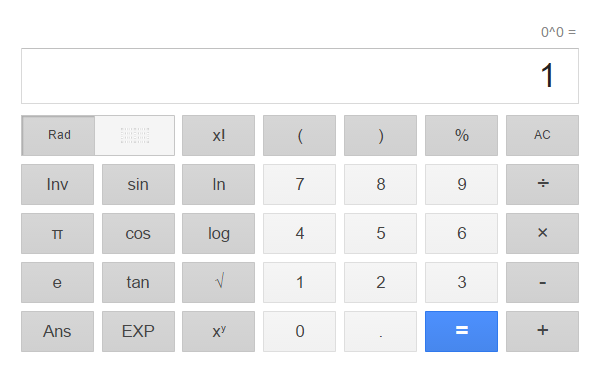
According to many Calculus textbooks and calculus classes, 0^0 is an indeterminate form''. When evaluating a limit of the form 0^0, then you need to know that limits of that form are calledindeterminate forms'', and that you need to use a special technique such as L'Hopital's rule to evaluate them. Otherwise, 0^0 = 1 seems to be the most useful choice for 0^0. This convention allows us to extend definitions in different areas of mathematics that otherwise would require treating 0 as a special case. Notice that 0^0 is a discontinuity of the function x^y. More importantly, keep in mind that the value of a function and its limit need not be the same thing, and functions need not be continous, if that serves a purpose (see Dirac's Delta).
This means that depending on the context where 0^0 occurs, you might wish to substitute it with 1, indeterminate or undefined/nonexistent.
Some people feel that giving a value to a function with an essential discontinuity at a point, such as x^y at (0,0), is an inelegant patch and should not be done. Others point out correctly that in mathematics, usefulness and consistency are very important, and that under these parameters 0^0 = 1 is the natural choice.
The following is a list of reasons why 0^0 should be 1.
Rotando & Korn show that if f and g are real functions that vanish at the origin and are analytic at 0 (infinitely differentiable is not sufficient), then f(x)^(g(x)) approaches 1 as x approaches 0 from the right.
From Concrete Mathematics p.162 (R. Graham, D. Knuth, O. Patashnik):
Some textbooks leave the quantity 0^0 undefined, because the functions x^0 and 0^x have different limiting values when x decreases to 0. But this is a mistake. We must define x^0 = 1 for all x, if the binomial theorem is to be valid when x=0, y=0, and/or x=-y. The theorem is too important to be arbitrarily restricted! By contrast, the function 0^x is quite unimportant.
Published by Addison-Wesley, 2nd printing Dec, 1988.
As a rule of thumb, one can say that 0^0 = 1, but 0.0^(0.0) is undefined, meaning that when approaching from a different direction there is no clearly predetermined value to assign to 0.0^(0.0); but Kahan has argued that 0.0^(0.0) should be 1, because if f(x), g(x) --> 0 as x approaches some limit, and f(x) and g(x) are analytic functions, then f(x)^g(x) --> 1.
The discussion on 0^0 is very old, Euler argues for 0^0 = 1 since a^0 = 1 for a != 0. The controversy raged throughout the nineteenth century, but was mainly conducted in the pages of the lesser journals: Grunert's Archiv and Schlomilch's Zeitschrift für Mathematik und Physik. Consensus has recently been built around setting the value of 0^0 = 1.
On a discussion of the use of the function 0^(0^x) by an Italian mathematician named Guglielmo Libri.
[T]he paper [33] did produce several ripples in mathematical waters when it originally appeared, because it stirred up a controversy about whether 0^0 is defined. Most mathematicians agreed that 0^0 = 1, but Cauchy [5, page 70] had listed 0^0 together with other expressions like 0/0 and oo - oo in a table of undefined forms. Libri's justification for the equation 0^0 = 1 was far from convincing, and a commentator who signed his name simply S'' rose to the attack [45]. August Möbius [36] defended Libri, by presenting his former professor's reason for believing that 0^0 = 1 (basically a proof that lim_(x --> 0+) x^x = 1). Möbius also went further and presented a supposed proof that lim_(x --> 0+) f(x)^(g(x)) whenever lim_(x --> 0+) f(x) = lim_(x --> 0+) g(x) = 0. Of courseS'' then asked [3] whether Möbius knew about functions such as f(x) = e^(-1/x) and g(x) = x. (And paper [36] was quietly omitted from the historical record when the collected words of Möbius were ultimately published.) The debate stopped there, apparently with the conclusion that 0^0 should be undefined.
But no, no, ten thousand times no! Anybody who wants the binomial theorem (x + y)^n = sum_(k = 0)^n (n k) x^k y^(n - k) to hold for at least one nonnegative integer n must believe that 0^0 = 1, for we can plug in x = 0 and y = 1 to get 1 on the left and 0^0 on the right.
The number of mappings from the empty set to the empty set is 0^0. It has to be 1.
On the other hand, Cauchy had good reason to consider 0^0 as an undefined limiting form, in the sense that the limiting value of f(x)^(g(x)) is not known a priori when f(x) and g(x) approach 0 independently. In this much stronger sense, the value of 0^0 is less defined than, say, the value of 0+0. Both Cauchy and Libri were right, but Libri and his defenders did not understand why truth was on their side.
The alternating sum of binomial coefficients from the n-th row of Pascal's triangle is what you obtain by expanding (1-1)^n using the binomial theorem, i.e., 0^n. But the alternating sum of the entries of every row except the top row is 0, since 0^k=0 for all k greater than 1. But the top row of Pascal's triangle contains a single 1, so its alternating sum is 1, which supports the notion that (1-1)^0=0^0 if it were defined, should be 1.
The limit of x^x as x tends to zero (from the right) is 1. In other words, if we want the x^x function to be right continuous at 0, we should define it to be 1.
The expression m^n is the product of m with itself n times. Thus m^0, the "empty product", should be 1 (no matter what m is).
Another way to view the expression mn is as the number of ways to map an n-element set to an m-element set. For instance, there are 9 ways to map a 2-element set to a 3-element set. There are NO ways to map a 2-element set to the empty set (hence 0^2=0). However, there is exactly one way to map the empty set to itself: use the identity map! Hence 0^0=1.
Here's an aesthetic reason. A power series is often compactly expressed as SUMn=0 to INFINITY an (x-c)n.
We desire this expression to evaluate to a^0 when x=c, but the n=0 term in the above expression is problematic at x=c. This can be fixed by separating the a^0 term (not as nice) or by defining 0^0=1.
Easy Math Editor
This discussion board is a place to discuss our Daily Challenges and the math and science related to those challenges. Explanations are more than just a solution — they should explain the steps and thinking strategies that you used to obtain the solution. Comments should further the discussion of math and science.
When posting on Brilliant:
*italics*or_italics_**bold**or__bold__paragraph 1
paragraph 2
[example link](https://brilliant.org)> This is a quote# I indented these lines # 4 spaces, and now they show # up as a code block. print "hello world"\(...\)or\[...\]to ensure proper formatting.2 \times 32^{34}a_{i-1}\frac{2}{3}\sqrt{2}\sum_{i=1}^3\sin \theta\boxed{123}Comments
Funny I was searching the internet and found proofs that 00=1 then I came to this, thinking I can find more, but it looks exactly the same.
Log in to reply
0^0 Web 2.0: ERROR: INDETERMINATE 0^0 Google: 1 0^0 Scientific Cal. : ERROR
Log in to reply
I'm sorry...google says what for 0^0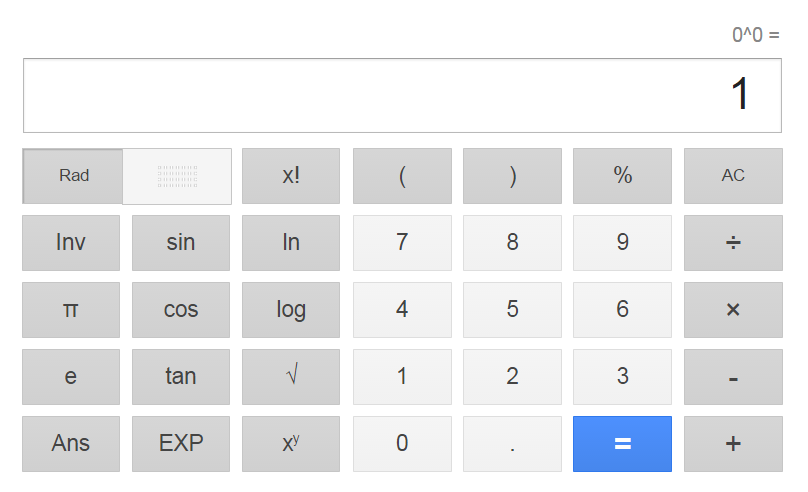
Just a question, a number raised to zero can be expressed as a^-1 * a^1 = a/a. Following the same logic 0^0 = 0/0. Now, is 0/0 = 1?
It is not necessary, can you find
x→0limxlogx1
It is of the form 00 but the answer is not 1.
Log in to reply
Funny; I got 10 as a final answer.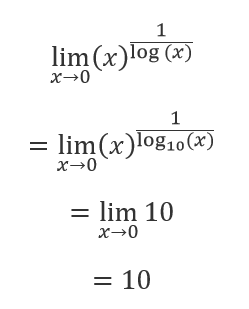
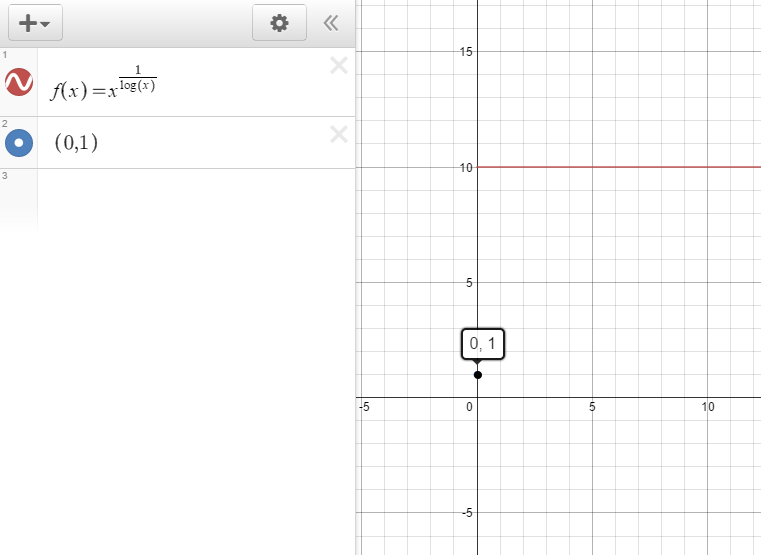
So now what do we get as a final conclusion.... Is it 1 or undefined ???? Am still confused
Log in to reply
Limits:
From the left of 0, it is undefined.
From the right of 0, it is 10.
At exactly 0, it is 1.
Get it, @Aditi Mishra ?
I posted a graph of it just now. Look at my post.
Log in to reply
No am asking for 0 to the power of 0 .... Do we consider as 1 or 0
Log in to reply
In most calculus classes and textbooks, they say 0. However, its true answer would have to be 1.
Log in to reply
Ohk thanks
Log in to reply
Welcome. I am not really sure why they say in classes that it is zero.
Also, take a took at this that I just did from desmos.com/calculator.
1 is the multiplicative identity of real numbers.
If n > 0, then 0^n = 0, because you multiply 1 n times by 0.
n^0 is as simple as not multiplying 1 by n. Thus n^0 = 1 for any real number n.
Log in to reply
For any real number.
I have checked a few sites just now and all are showing various answers.
Symbolab.com: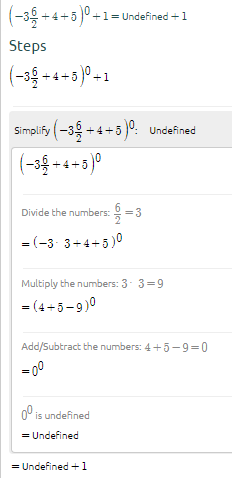
Cymath.com: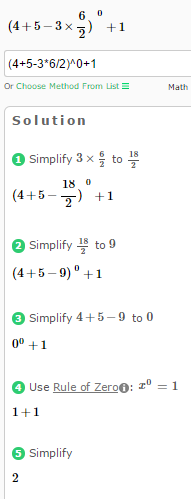
WolframAlpha.com: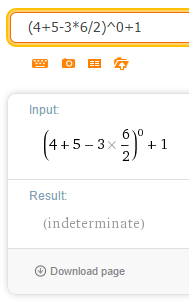
@Llewellyn Sterling Obviously, the reason for saying n^0 = 1 is, n^2 = 1 x n x n n^1 = 1 x n = n^2 / n n^0 = (1xn)/n = 1 But in this case, n = 0. which implies n^0 = 1/0 which is undefined.